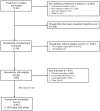Establishing the prevalence of incontinence study: racial differences in women's patterns of urinary incontinence
- PMID: 18295278
- PMCID: PMC2879624
- DOI: 10.1016/j.juro.2007.11.051
Establishing the prevalence of incontinence study: racial differences in women's patterns of urinary incontinence
Erratum in
- J Urol. 2008 Jul;180(1):415. Patel, Divya L [corrected to Patel, Divya A]
Abstract
Purpose: We examine racial differences in urinary incontinence prevalence, frequency, quantity, type, and risk factors in a population based sample of community dwelling black and white women.
Materials and methods: Women 35 to 64 years old were sampled from telephone records from 3 southeast Michigan counties. Women self-identifying as black or white race completed a telephone interview that assessed demographics, health history, lifestyle factors and urinary incontinence experience. Statistical analysis included descriptive statistics, factor analysis and multivariable logistic regression to determine adjusted odds of urinary incontinence. Estimates were weighted to reflect probability and nonresponse characteristics of the sample, and to increase generalizability of the findings.
Results: Interviews were completed by 1,922 black and 892 white women (response rate = 69%). The overall prevalence of urinary incontinence was 26.5%. By race, urinary incontinence prevalence was 14.6% for black women and 33.1% for white women (p <0.001). Among incontinent women there was no difference by race in the frequency of urinary incontinence. However, black women reported more urine loss per episode (p <0.05). A larger proportion of white women with incontinence (39.2%) reported symptoms of pure stress incontinence compared to black women (25.0%), whereas a larger proportion of black women (23.8%) reported symptoms of pure urge incontinence compared to white women (11.0%). Risk factors for urinary incontinence were generally similar for white and black women.
Conclusions: In this population based study we observed racial differences in prevalence, quantity and type of urinary incontinence. Frequency of and risk factors for urinary incontinence were generally similar for white and black women.
Figures
References
-
- Diokno AC, Brock BM, Brown MB, Herzog AR. Prevalence of urinary incontinence and other urological symptoms in the noninstitutionalized elderly. J Urol. 1986;136:1022. - PubMed
-
- Burgio KL, Matthews KA, Engel BT. Prevalence, incidence and correlates of urinary incontinence in healthy, middle-aged women. J Urol. 1991;146:1255. - PubMed
-
- Nygaard IE, Lemke JH. Urinary incontinence in rural older women: prevalence, incidence and remission. J Am Geriatr Soc. 1996;44:1049. - PubMed
-
- Brown JS, Grady D, Ouslander JG, Herzog AR, Varner RE, Posner SF. Prevalence of urinary incontinence and associated risk factors in postmenopausal women. Heart & Estrogen/Progestin Replacement Study (HERS) Research Group. Obstet Gynecol. 1999;94:66. - PubMed
-
- Melville JL, Katon W, Delaney K, Newton K. Urinary incontinence in US women: a population-based study. Arch Intern Med. 2005;165:537. - PubMed
Publication types
MeSH terms
Grants and funding
LinkOut - more resources
Full Text Sources
Medical


